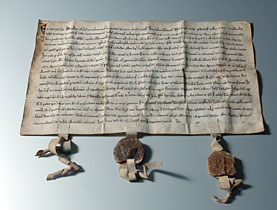
Historians question federal charter

As they do every year on August 1, the Swiss on Saturday commemorated the pact signed by their forefathers in 1291.
But historian Georges Andrey draws swissinfo.ch’s attention to a few inconsistencies in the roots of Switzerland’s national day, which was created just over 100 years ago.
Legend has it that on August 1, 1291, amid continuing Habsburg repression, representatives from three forest cantons around Lake Lucerne – Uri, Schwyz and Unterwalden – met on the Rütli meadow to sign a pact of eternal mutual defence. This is said to have laid the foundation of the Switzerland of today.
The Museum of Schwyz exhibits the only copy of the Federal Charter, owned by canton Schwyz, that survived the test of time.
However, for many years researchers have raised doubts about this version of events. Andrey, author of Swiss History for Dummies, explains the latest scientific consensus.
swissinfo.ch: What really happened on August 1, 1291?
Georges Andrey: Possibly nothing, for the simple reason that the 1291 charter hasn’t been dated precisely. The original Latin text says “initio augusto” – that’s to say the beginning of August not August 1. But obviously it was necessary to pick a date, which is why in 1891 the government decided the text was dated August 1.
swissinfo.ch: Why did it do that?
G.A.: Switzerland was one of the last countries to have no national holiday, so they needed to find a pretext. The historians of the day were consulted and they came up with this charter, which is an updated version of an oath from a previous charter, which has never been found.
This is the basis on which all of Switzerland commemorates this alliance. On August 1, 1891 every clock tower in the country rang simultaneously and fires were lit. Swiss National Day has been celebrated on August 1 ever since.
swissinfo.ch: The date isn’t the only inaccuracy…
G.A.: There are indeed other problems with the document. For one, it’s not signed – not one person is mentioned in the text – and for another, neither is a single place. As a result, the idea of some sort of alliance taking place on the Rütli is also debatable.
As there are no names mentioned, historians did a bit of digging. Certain names were already known by the 14th century. Looking at the situation today, we can put forward certain names, all of whom represent the political elite of the three forest cantons at the end of the 13th century.
Traditionally, the history books contain the names of three people who are said to have signed the pact in 1291: Walter Fürst, Arnold de Melchtal and Werner Stauffacher. But that’s purely hypothetical – in fact if three names have been kept, it’s because the number three represents the Trinity and is therefore a symbol of authority.
swissinfo.ch: Can we still say that the 1291 charter is Switzerland’s founding document?
G.A.: Historians agree that the pact is anything but a modern constitution. In fact it’s a patchwork of texts probably picked up elsewhere – we don’t know where – and put together into a medieval charter according to the practice of the day.
Reading the text is astonishing. It mentions public law, criminal law, international law, the suppression of fraud, judicial cooperation… A lot of emphasis is placed on legal autonomy: the forest cantons didn’t want foreign judges.
Another thing that strikes you is a certain incoherence in the text. For example sometimes you find the plural “they” and sometimes the royal “we”. There are also spelling mistakes, which don’t look good…
For some historians that reflects a certain haste in writing the text. They think it was written in a rush and in secret, as though there were outside pressure. It should also be pointed out that the Latin word which was translated as “confederates” was “conspirati”. This proves for some historians that the pact is well and truly a pact of rebellion.
swissinfo.ch: Recently even the authenticity of the pact has been doubted.
G.A.: Last year the Zurich medievalist Roger Sablonier used radiometric dating to show that many medieval charters in our possession – including the 1291 pact – were not authentic.
But hang on. By no means does that indicate that the texts are fake. Indeed, Sablonier isn’t claiming that. Basically these analyses show that the charters we have are younger than the text by one, two or three generations. In fact they were retranscribed for various reasons – for example, because the original parchment had been damaged by humidity, fire or even rats.
Olivier Pauchard, swissinfo.ch (translated from French by Thomas Stephens)
The Federal Charter is a written pact signed by the three small cantons that formed the core of Switzerland on August 1, 1291.
The charter forged an alliance of mutual protection between the cantons of Schwyz, Uri and Unterwalden against external threats, principally the Habsburg Empire at that time.
Some historians say the charter provides the basis for a democratic government and emphasis the power of the judiciary.
The document came after the English Magna Carta of 1215. But in contrast to the Magna Carta, the Swiss accord embraces democratic principles outside a monarchy.
It is not clear how many copies of the charter – written in Latin – existed and if some of them were lost.
The Museum of Schwyz exhibits the only copy – owned by canton Schwyz – that survived the test of time. The document travelled to Philadelphia under high security in 2006.
Georges Andrey was born in Lausanne in 1939.
He studied Classics and philosophy in France and gained a doctorate in history at Fribourg University.
He then worked at Bern University, in the area of electoral history, and at the end of the 1970s he split his time between being a civil servant and teaching at Fribourg University.
Many of Andrey’s publications deal with Swiss-French relations and he is also author of a chapter of The New History of Switzerland and the Swiss, published in the 1980s.
In 2007 he wrote Swiss History for Dummies, which has sold more than 20,000 copies.

In compliance with the JTI standards
More: SWI swissinfo.ch certified by the Journalism Trust Initiative






























You can find an overview of ongoing debates with our journalists here . Please join us!
If you want to start a conversation about a topic raised in this article or want to report factual errors, email us at english@swissinfo.ch.